Research of the Polymerization Process of Polymers and Protective Metal Coatings to Face the Elements
ABSTRACT
This article describes the methods of coating polymer coatings and the work efficiency of the coating coated details. Polymeric coatings are made of polymeric materials and can be applied on a number of substrates using a variety of methods such as extrusion/dispersion and solution casting techniques. Polymeric coatings provide excellent adherence to and protection from the environment.
KEYWORDS: Polymer, coating, corrosion, property, matrix, environment, surface, composite, structure, temperature.
Introduction. Naturally occurring polymers those derived from plants and animals have been used for many centuries; these materials include wood, rubber, cotton, wool, leather, and silk. Other natural polymers, such as proteins, enzymes, starches, and cellulose, are important in biological and physiological processes in plants and animals. Modern scientific research tools have made possible the determination of the molecular structures of this group of materials and the development of numerous polymers that are synthesized from small organic molecules. Many of our useful plastics, rubbers, and fiber materials are synthetic polymers. In fact, since the conclusion of World War II, the field of materials has been virtually revolutionized by the advent of synthetic polymers. The synthetics can be produced in expensively, and their properties may be managed to the degree that many are superior to their natural counterparts. In some applications, metal and wood parts have been replaced by plastics, which have satisfactory properties and can be produced at a lower cost. This type of polymerization involves the presence of two or three unsaturated molecules, especially carbon carbon [1].
In today's fast paced time, synthetic raw materials are replacing natural materials. in particular, polymerized polymer materials have become the main raw material for the manufacturing industry. Polyethylene, polypropylene, phenol formaldehyde and other types of polymers are widely used in industry. The advantage of thermoplastic polymers is that they can be recycled. we can also see this process in the production of film and fiber. Coatings made of thermoplastic polymers, especially films, which protect the metal surface from corrosion and the external environment are very important.
Methods and Analysis
The word polymer is derived from a Greek word, where ―poly‖ means many and ―mers‖ means particles. So, polymer can be described as a combination of identical molecules called mers. Polymers are composed of repeat units of small compounds called monomers. Different polymers show different properties, depending upon how the monomers are linked with each other. Some polymers are hard, such as bakelite and glass; whereas some are soft, such as biopolymers, silk, and
Middle European Scientific Bulletin, VOLUME 24 May 2022
Mamataliyeva Zulfiyakhon Khusanovna Andijan Machine Building Institute of Assistant Makhammadjanov Khusanboy Alisher o‘g‘li Andijan machine building institute, basic doctoral student
rubber. Polymers are found to have several and the use of both natural and man made polymers is widespread in applications our society. The natural polymers include proteins and polysaccharides, and the man made polymers include synthetic plastics and fibers [2].
Their applications range from households to industries such as transportation, aviation, and pharmaceuticals. Their extensive use is in the area of medical devices, food packaging, decoration, transportation, information technology, and so on. Polymers are represented by repeating structural units called monomer. For example, a simple and long chain polymer polyethylene, with ethylene as a repeat unit and n as its number of repetition, is expressed as follows:
The dissolution of polymers is different from the low molecular weight compound. Long dissolution time and enhanced viscosity of their solution make them unique. To obtain homogeneous solution, one can make use of solubility parameters and predict the solubility of polymer in the solvent. When these data are not available, trials with various solvents would be needed.
Polymeric coatings are made of polymeric materials and can be applied on a number of substrates using a variety of methods such as extrusion/dispersion and solution casting techniques. Polymeric coatings provide excellent adherence to and protection from the environment. They are so designed that they adhere well to the substrate and not peel off easily, nor degrade due to heat, moisture, salt, or chemicals. Coatings are made up with different ingredients such as solvent, additives, and thinners. Different ingredients play different roles in coatings, such as additives enhance the functional properties. Similarly, thinners reduce the viscosity of the mixture, making the final coat appear smooth and without any defect [3].
Coatings are mainly used in the following sectors:

Transportation: The coatings provide protection from weather such as heat/ light, corrosion, and scratches from accidents such as dents.
Household: The coatings provide finishing to kitchen appliances, such as Teflon coating and anti heating properties to utensils.
Medicines: The coatings are used to coat drugs and thereby reduce contact with viruses and bacteria.
Industry: In industries, coatings provide protection to equipment such as pipelines from weathering, extreme heat/light, and corrosion; in membrane industry, coating is used for the selective separation of gases.
Cosmetics: Coating is widely used in creams, glasses, nail paints, etc.
Energy: In this sector, coatings act as a protective barrier against extreme heat and light, enable easy dust removal, serve as an O2 barrier, such as in wind energy and solar energy panels, and so on.
The use of coatings have increased extensively in automobile, aerospace, aircraft, marine, membranes, magnetic media, storage devices, and food industry. They are also used in the oil and gas industry for corrosion control, encapsulation of electronic circuits, textile industry for making breathable clothing, and surface engineering industry for manufacturing of multilayer coatings that are used in various transportation and infrastructure applications, implantable devices, and materials for protection from the weathering conditions. Polymeric coatings are prepared with or without solvents. Coatings of one polymer and one solvent are called binary coatings. Multi component coatings have more than one polymer/solvent.
Middle European Scientific Bulletin, VOLUME 24 May 2022
Polymeric coating chemistry is different from that of polymers. The coating includes polymer matrix or binder: the polymer phase that holds all the constituents together. In polymeric coatings, we add fillers, pigments, surfactants, plasticizers, and binders to impart hardness/flexibility, strength, weather protection, color, gloss, and reflectance. The interface plays an important role in the performance of polymeric coatings. The main types of interfaces are substrate (bottom), coating air (top), and additives (internal). Other interfaces that also play a role are solid gas, solid liquid, and gas liquid interfaces (e.g., in drying paints). Flow and leveling properties greatly influence the appearance and performance of coatings. The polymer phase present on the surface and its chemistry is far different from the bulk polymers. The interesting characteristics of polymer coatings are that they are easily spread and handled [4]. They can be applied as liquids as in the case of paints, and various additives may be added to enhance their properties. Some other properties such as flexibility, drying, and self healing are the ones where molecular mobility plays an important role. The advanced polymeric coatings are thermosetting in nature, despite that a large majority of polymeric materials are thermoplastics. It is easy to predict the molecular mobility of thermoplastic polymers because their entangled macromolecules are still largely independent. However, in thermosetting polymers, the network structure strongly hinders the molecular mobility.
Wether it concerns electricity poles, coils, gas canisters or drilling platforms, they all have to withstand the elements or frequent handling. This requires metal coatings with exceptional performance and Stahl delivers just that. Our polymer technologies protect metal products and outdoor constructions against damage and corrosion, while meeting safety standards and regulation [5].
Anti-corrosive, resistant and safe coating technologies
One of the main challenges for metal surfaces is preventing corrosion. Stahl Polymers provides resins that are alkylphenol epoxylates (APEO) free. This enables alternative solutions that protect metal products and constructions from the oxidizing effects of water and humidity. This ensures their long time high performance functionality. At the same time, metal or metal coated products face a lot of heavy duty handling. Think of gas canisters or bottles or industrial drums, which require a hard, scratch resistant coating. Water based acrylic polymers are a vital component of chemical resistance properties required for industrial coatings that also retains their flexibility. We even design polymeric solutions that withstand the extreme conditions of a marine environment [6]. Thanks to the versatility in polymer technologies we offer, compatibility and easy formulating, we can provide resin solutions with excellent results. Resins that offer protection for metal surfaces with high gloss, high scratch and abrasion resistance, with high flexibility and extremely high chemical resistance.
Working with Stahl as partner for metal coating solutions
Stahl’s expertise in responsible chemistry has helped us become a rapid market leader in the field of metal coatings with a portfolio of acrylics and polyurethanes that are leading in performance. Additionally, we provide direct technical service to even our small scale clients as we value each equally and understand their pressing needs for the right fit technologies. With first class resins, we can help formulate coatings that create hard surfaces with resistant film that leaves no cracks and holes, ensuring durable and long term protection. As we produce locally, we can also provide fast services.
Key Benefits of Stahl’s metal solutions
There are numerous advantages to opting for Stahl Polymers when it comes to resins for metal surfaces. In addition, we can create solutions tailored to your precise needs in performance and legislative requirements [7].
Middle European Scientific Bulletin,
Key benefits:
Excellent adhesion on metal
Very good corrosion resistance
Solvent free and low VOC
High hardness
Excellent chemical resistances
From high gloss to satin/matt formulations
Metal solutions portfolio overview
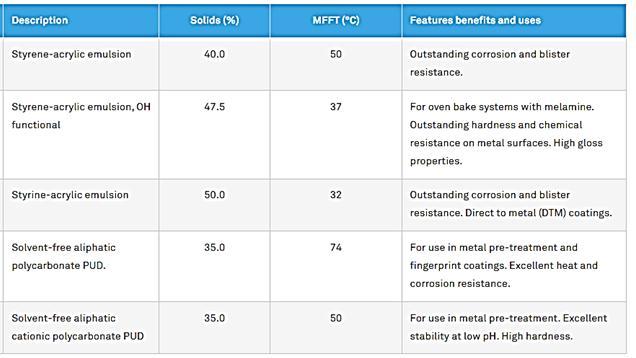
Material property combinations and ranges have been, and are yet being, extended by the development of composite materials. Generally speaking, a composite is considered to be any multiphase material that exhibits a significant proportion of the properties of both constituent phases such that a better combination of properties is realized. According to this principle of combined action, better property combinations are fashioned by the judicious combination of two or more distinct materials. Property trade offs are also made for many composites. Composites of sorts; these include multiphase metal alloys, ceramics, and polymers. For example, pearlitic steels have a microstructure consisting of alternating layers of ferrite and cementite. The ferrite phase is soft and ductile, whereas cementite is hard and very brittle.[8] . The combined mechanical characteristics of the pearlite (reasonably high ductility and strength) are superior to those of either of the constituent phases.
A number of composites also occur in nature. For example, wood consists of strong and flexible cellulose fibers surrounded and held together by a stiffer material called lignin. Also, bone is a composite of the strong yet soft protein collagen and the hard, brittle mineral apatite. A composite, in the present context, is a multiphase material that is artificially made, as opposed to one that occurs or forms naturally. In addition, the constituent phases must be chemically dissimilar and separated by a distinct interface. In designing composite materials,
Middle European Scientific Bulletin, VOLUME 24 May 2022
scientists and engineers have ingeniously combined various metals, ceramics, and polymers to produce a new generation of extraordinary materials. Most composites have been created to improve combinations of mechanical characteristics such as stiffness, toughness, and ambient and high temperature strength. Many composite materials are composed of just two phases; one is termed the matrix, which is continuous and surrounds the other phase, often called the dispersed phase. The properties of composites are a function of the properties of the constituent phases, their relative amounts, and the geometry of the dispersed phase. Dispersed phase geometry in this context means the shape of the particles and the particle size, distribution, and orientation; these characteristics are represented in Figure1.One simple scheme for the classification of composite materials is shown in Figure2, which consists of three main divisions: particle reinforced, fiber reinforced, and structural composites; also, at least two subdivisions exist for each. The dispersed phase for particle reinforced composites is equiaxed (i.e., particle dimensions are approximately the same in all directions); for fiber reinforced composites, the dispersed phase has the geometry of a fiber (i.e., a large length to diameter ratio).Structural composites are combinations of composites and homogeneous materials. The discussion of the remainder of this chapter will be organized according to this classification scheme.[9]
Figure 1.Schematic representations of the various geometrical and spatial characteristics of particles of the dispersed phase that may influence the properties of composites: (a) concentration, (b) size, (c) shape, (d) distribution, and (e) orientation.

Figure 2. Aclassification scheme for the various composite types
Some polymeric materials to which fillers have been added are really large particle composites. Again, the fillers modify or improve the properties of the material and/or replace some of the polymer volume with a less expensive material the filler. Another familiar large particle composite is concrete, which is composed of cement (the matrix) and sand and gravel (the particulates). Particles can have quite a variety of geometries, but they should be of approximately the same dimension in all directions (equiaxed).[10]. For effective reinforcement, the particles should be small
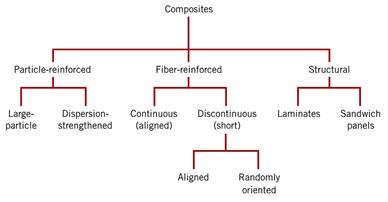
Middle European Scientific Bulletin, VOLUME 24 May 2022
and evenly distributed throughout the matrix. Furthermore, the volume fraction of the two phases influences the behavior; mechanical properties are enhanced with increasing particulate content. Two mathematical expressions have been formulated for the dependence of the elastic modulus on the volume fraction of the constituent phases for a two phase composite. These rule of mixtures equations predict that the elastic modulus should fall between an upper bound represented by (1)
and a lower bound, or limit, (2)
In these expressions, E and V denote the elastic modulus and volume fraction, respectively, whereas the subscripts c, m, and p represent composite, matrix, and particulate phases. Figure3.plots upper and lower bound Ec versus Vp curves for a copper tungsten composite, in which tungsten is the particulate phase; experimental data points fall between the two curves. Equations analogous to (1) and (2)for fiber reinforced composites are derived.[11]
Figure 3.Modulus of elasticity versus volume percent tungsten for a composite of tungsten particles dispersed within a copper matrix. Upper and lower bounds are according to Equations 1 and 2; experimental data points are included.
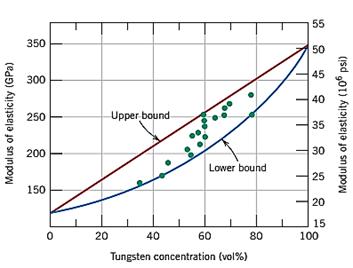
Large particle composites are used with all three material types (metals, polymers, and ceramics). The cermets are examples of ceramic metal composites. The most common cermet is cemented carbide, which is composed of extremely hard particles of a refractory carbide ceramic such as tungsten carbide (WC) or titanium carbide (TiC), embedded in a matrix of a metal such as cobalt or nickel. These composites are used extensively as cutting tools for hardened steels. The hard carbide particles provide the cutting surface but, being extremely brittle, are not themselves capable of withstanding the cutting stresses. Toughness is enhanced by their inclusion in the ductile metal matrix, which isolates the carbide particles from one another and prevents particle to particle crack propagation. Both matrix and particulate phases are quite refractory, to withstand the high temperatures generated by the cutting action on materials that are extremely hard. No single material could possibly provide the combination of properties possessed by a cermet.[12] Relatively large volume fractions of the particulate phase may be used, often exceeding 90 vol%; thus the abrasive action of the composite is maximized. A photomicrograph of a WC Co cemented carbide is shown in Figure 4.

Middle European Scientific Bulletin,
Figure 4. Photomicrograph of a WC Co cemented carbide. Light areas are the cobalt matrix; dark regions, the particles of tungsten carbide. 100x.
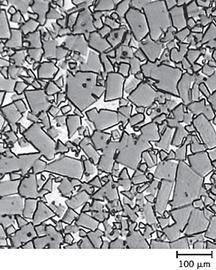
Figure 5. Electron micrograph showing the spherical reinforcing carbon black particles in a synthetic rubber tire tread compound. The areas resembling water marks are tiny air pockets in the rubber. 80,000 x.
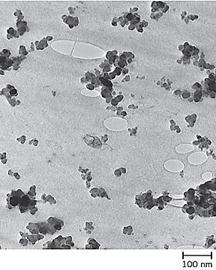
Both elastomers and plastics are frequently reinforced with various particulate materials. Our use of many of the modern rubbers would be severely restricted without reinforcing particulate materials such as carbon black. Carbon black consists of very small and essentially spherical particles of carbon, produced by the combustion of natural gas or oil in an atmosphere that has only a limited air supply. When added to vulcanize rubber, this extremely inexpensive material enhances tensile strength, toughness, and tear and abrasion resistance. Automobile tires contain on the order of 15 to 30 vol% carbon black. For the carbon black to provide significant reinforcement, the particle size must be extremely small, with diameters between 20 and 50 nm; also, the particles must be evenly distributed throughout the rubber and must form a strong adhesive bond with the rubber matrix. Particle reinforcement using other materials (e.g., silica) is much less effective because this special interaction between the rubber molecules and particle surfaces does not exist. Figure 5. is an electron micrograph of a carbon black reinforced rubber.[13]
Conclusion/Recommendations
In conclusion, it should be noted that the speed and quality of production will increase as the manufacturing industry improves polymeric materials that replace natural materials and metals.
Middle European Scientific Bulletin,
EUROPEAN SCIENTIFIC BULLETIN ISSN 2694-9970
Films and fibers are used in all fields of machinery. This article describes the methods of production and modification of films and fibers using modern methods, as well as coating the detail surface with polymer coatings. it should be noted that the current rapidly developing era of innovation requires the use of more reliable and cheaper raw materials. Therefore, this article describes in detail the methods of obtaining a material with desired properties in composite form by connecting the elements together.
References:
1. Tim A.Osswald and Georg Menges ―Material Science of Polymers for Engineers‖ 3rd Edition. Carl Hanser Verlag, Munich 2012.
2. Soumya Mondal, Dipak Khastgir ―Carbon Containing Polymer composites‖. Springer Singapore 2019.
3. У.А.Зиямухамедова. «Перспективные
минеральных и энергетических
2011
William D.Callister, Jr. David G. Rethwisch ―Materials science and engineering 8th edition‖. USA 2010.
5. Khusanboy Makhammadjanov, R. Karimov ―Research fabrication of fibers and films‖ A Multidisciplinary Peer Reviewed Journal NX. 2020
6. Khusanboy Makhammadjanov, D.Gofurjanov ―Research of the structure of composite materials‖ ACADEMICIA An International Multidisciplinary research journal. November 2020.
7. Б.Тожибоев, Х.Махаммаджанов ―Разработка полимерных композитов на основе политетрафторэтилена и базальтового волокна‖ НамМТИ Илмий-Техника журнали. Махсус сон №1, 2019
8. Б.Тожибоев, Н.А.Икрамов Исследование свойств радиационно обработанных наполненых композиционных полимерных покрытий ℽ лучами Universum: Технические науки Выпуск: Москва 12(81) декабрь
